

Metátesis. Abugida. An abugida /ˌɑːbuːˈɡiːdə/[citation needed] (from Ge‘ez አቡጊዳ ’äbugida), also called an alphasyllabary, is a segmental writing system in which consonant–vowel sequences are written as a unit: each unit is based on a consonant letter, and vowel notation is secondary.
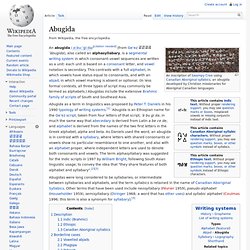
This contrasts with a full alphabet, in which vowels have status equal to consonants, and with an abjad, in which vowel marking is absent or optional. (In less formal contexts, all three types of script may commonly be termed as alphabets.) Abugidas include the extensive Brahmic family of scripts of South and Southeast Asia.
Abugida as a term in linguistics was proposed by Peter T. Daniels in his 1990 typology of writing systems.[1] ’Abugida is an Ethiopian name for the Ge‘ez script, taken from four letters of that script, ’ä bu gi da, in much the same way that abecedary is derived from Latin a be ce de, and alphabet is derived from the names of the two first letters in the Greek alphabet, alpha and beta. Bahuvrihi. In English bahuvrihis, the last constituent is usually a noun, while the whole compound is a noun or an adjective.
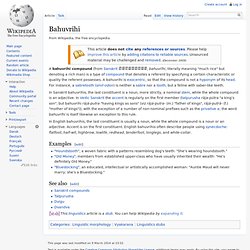
Accent is on the first constituent. English bahuvrihis often describe people using synecdoche: flatfoot, half-wit, highbrow, lowlife, redhead, tenderfoot, longlegs, and white-collar. Examples[edit] "Houndstooth", a woven fabric with a patterns resembling dog's teeth: "She's wearing houndstooth. ""Old Money", members from established upper-class who have usually inherited their wealth: "He's definitely Old Money. "" Phonological history of Catalan. Nodicia de Kesos. Inchoative verb. Latin[edit] The Latin language uses the infix -sc- to show inchoative force.
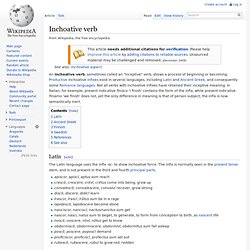
The infix is normally seen in the present tense stem, and is not present in the third and fourth principal parts. Verb incoatiu. Els verbs incoatius són un nombrós grups de verbs del grup III que, en la conjugació dels seus presents d'indicatiu i de subjuntiu, adjunten a l'arrel un element de naturalesa discutida (encara que majoritàriament es considera un tipus de morfema), que s'anomena habitualment increment.
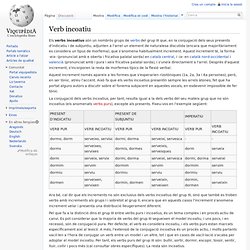
Aquest increment té, la forma -eix- (pronunciat amb e oberta i fricativa palatal sorda) en català central, i -ix- en català nord-occidental i valencià (pronunciat amb i pura i xeix fricativa palatal sorda), i s'uneix directament a l'arrel. Després d'aquest increment, s'incorporen la resta de morfemes típics de la flexió verbal. Betacismo. El betacismo es un fenómeno lingüístico muy característico, sobre todo, de algunas lenguas romances (español, gallego, a veces catalán, y también occitano, sardo, dialectos norteños del portugués y algunos dialectos sureños de Italia, aunque también se da esporádicamente en rumano y otras lenguas y dialectos romances) que consiste en unir la pronunciación de los sonidos [b] y [β] o [v].

También existe en otras lenguas (por ejemplo el griego), ya que se trata de uno de los fenómenos de la evolución fonética más comunes, independientemente de la genealogía lingüística. Las explicaciones dadas a continuación se refieren en especial al betacismo de las lenguas románicas. Consonant voicing and devoicing. For example, English suffix -s is pronounced [s] when it follows a voiceless phoneme (cats), and [z] when it follows a voiced phoneme (dogs).[1] This type of assimilation is called progressive, where the second consonant assimilates to the first; regressive assimilation goes in the opposite direction, as can be seen in have to [hæftə].

English[edit] belief - believelife - liveproof - provestrife - strivethief - thieveba[θ] - ba[ð]ebrea[θ] - brea[ð]emou[θ] (n.) - mou[ð] (vb.)shea[θ] - shea[ð]ewrea[θ] - wrea[ð]ehou[s]e (n.) - hou[z]e (vb.)u[s]e (n.) - u[z]e (vb.) Synchronically, the assimilation at morpheme boundaries is still productive, such as in:[2] cat + s → catsdog + s → do[ɡz]miss + ed → mi[st]whizz + ed → whi[zd] The voicing alternation found in plural formation is losing ground in the modern language,[citation needed], and of the alternations listed below many speakers retain only the [f-v] pattern, which is supported by the orthography. Hyperforeignism. A hyperforeignism is a non-standard language form resulting from an unsuccessful attempt to apply the rules of a foreign language to a loan word (for example, the application of the rules of one language to a word borrowed from another) or, occasionally, a word believed to be a loan word.
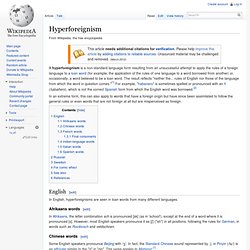
The result reflects "neither the... rules of English nor those of the language from which the word in question comes. "[1] For example, "habanero" is sometimes spelled or pronounced with an ñ (habañero), which is not the correct Spanish form from which the English word was borrowed.[2] In an extreme form, this can also apply to words that have a foreign origin but have since been assimilated to follow the general rules or even words that are not foreign at all but are misperceived as foreign. GENERATIVISMO: Generativismo. GENERATIVISMODE NOAM CHOMSKY Es un modelo de gramática que tiene unas reglas y principios específicos para que el hablante pueda comprender, hablar y producir todas las oraciones de su propia lengua.

Se caracteriza por ser una escuela opuesta al estructuralismo americano de Bloomfield. Aquí se muestran las relaciones sintagmáticas, es decir las funciones gramaticales como concordancia y función de las palabras. Mater lectionis. History[edit] Because the scripts used to write some Semitic languages lack vowel letters, unambiguous reading of a text might be difficult.

Therefore, to indicate vowels (mostly long), consonant letters are used. For example, in the Hebrew construct-state form bēt, meaning "the house of", the middle letter "י" in the spelling בית acts as a vowel, whereas in the corresponding absolute-state form bayit ("house"), which is spelled the same, the same letter represents a genuine consonant. Sendebar. Manuscrito del Sendebar.
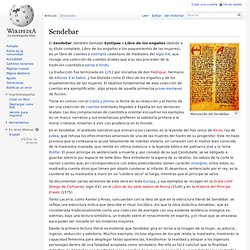
Orígenes de los términos educativos "Clase" y "Currículum. Está en: OEI - Revista Iberoamericana de Educación - Revista Iberoamericana de Educación 1 - David Hamilton (*) (*) Universidad de Liverpool. Glosas Emilianenses. Página 72 del Códice Emilianense 60. Se aprecia la glosa al margen. Las Glosas Emilianenses son pequeñas anotaciones manuscritas, realizadas en varias lenguas: latín, un romance hispánico (bien navarro-aragonés en su variedad riojana, bien castellano[1] con elementos riojanos[2] ) y vascuence medieval, entre líneas o en los márgenes de algunos pasajes del códice latino Aemilianensis 60 a finales del siglo X o con más probabilidad a principios del siglo XI.
La intención del monje copista era probablemente la de aclarar el significado de algunos pasajes del texto latino. TODO SOBRE EL ANÁLISIS SINTÁCTICO. La oración que tiene SUJETO y PREDICADO se llama bimembre. ___S________P___Los niños llegaron El sujeto es la parte de la oración que nos indica quién o qué cosa realiza la acción. **Sujeto expreso: Está escrito en la oración. Sujeto expreso simple o compuesto: Se clasifica de acuerdo al número de núcleos que tenga. Sujeto expreso simple: Tiene un núcleo. Sujeto expreso compuesto: Tiene más de un núcleo. ***Sujeto tácito: No está escrito en la oración, pero se puede identificar reemplazándolo por un pronombre. TPR Storytelling. Proponents of TPR Storytelling, basing their argument on the second language acquisition theories of Stephen Krashen, hold that the best way to help students develop both fluency and accuracy in a language is to expose them to large amounts of comprehensible input.[1] The steps and techniques in TPR Storytelling help teachers to provide this input by making the language spoken in class both comprehensible and engaging.
In addition, TPR Storytelling uses many concepts from mastery learning. Each lesson is focused on just three vocabulary phrases or fewer, enabling teachers to concentrate on teaching each phrase thoroughly. Teachers also make sure that the students internalize each phrase before moving on to new material, giving additional story lessons with the same vocabulary when necessary. TPR Storytelling is unusual in that it is a grassroots movement among language teachers. English to Spanish Translation, Dictionary and Translator. Diccionario Clarín - Clarin.com. ! PALABRAS INTERESANTES, HERMOSAS, RARAS Y DIVERTIDAS: DEFINICION, SIGNIFICADO, EJEMPLOS, ORIGEN, ETIMOLOGIA, SINONIMOS. Real Academia Española. Wiktionary. Biblioteca Virtual Miguel de Cervantes.